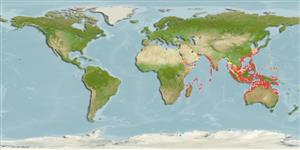Actinopterygii (ray-finned fishes) >
Perciformes (Perch-likes) >
Haemulidae (Grunts) > Haemulinae
Etymology: Pomadasys: Greek, poma, -atos = cover, operculum + Greek, dasys = with hair (Ref. 45335).
Environment / Climate / Range
Ecology
Marine; brackish; reef-associated; depth range ? - 75 m (Ref. 2799). Tropical, preferred 27°C (Ref. 107945); 32°N - 32°S, 18°E - 154°E
Indo-West Pacific: Red Sea and east coast of Africa to southeast Asia, north to Taiwan, south to Queensland, Australia. Also reported from Persian Gulf (Ref. 68964).
Length at first maturity / Size / Weight / Age
Maturity: Lm ?, range 35 - ? cm
Max length : 80.0 cm TL male/unsexed; (Ref. 5213); common length : 50.0 cm TL male/unsexed; (Ref. 30573)
Dorsal
spines
(total): 12;
Dorsal
soft rays
(total): 13-15;
Anal
spines: 3;
Anal
soft rays: 7 - 8. Body is slender; the head profile slightly convex; lips not thickened; 2 pores and a central groove under the chin. No antrorse spine before the dorsal fin origin; a deep notch between the spinous and the soft-rayed portion of the dorsal fin. Color is generally silvery with a golden tint on the sides; the upper operculum olive-yellow; the snout dusky, overlain with yellow. Young specimens have 7-11 vertical bands on the upper sides; older ones with bands formed by spots aligned in vertical rows.
Inhabit turbid inshore waters with sandy to muddy bottoms to a depth of 75 m. Enter estuaries, may tolerate water with low salinity. Often associated with inshore wrecks (Ref. 4332). Feed on crustaceans and fish (Ref. 5213, 48635). Spawners form shoals near river mouths during the winter. Good food fish (Ref. 2799).
Life cycle and mating behavior
Maturity | Reproduction | Spawning | Eggs | Fecundity | Larvae
Oviparous, distinct pairing during breeding (Ref. 205).
Smith, M.M. and R.J. McKay, 1986. Haemulidae. p. 564-571. In M.M. Smith and P.C. Heemstra (eds.) Smiths' sea fishes. Springer-Verlag, Berlin. (Ref. 2799)
IUCN Red List Status (Ref. 115185)
CITES (Ref. 94142)
Not Evaluated
Threat to humans
Harmless
Human uses
Fisheries: commercial; aquaculture: commercial; gamefish: yes
More information
ReferencesAquacultureAquaculture profileStrainsGeneticsAllele frequenciesHeritabilityDiseasesProcessingMass conversion
Tools
Can't connect to MySQL database fbquizv2. Errorcode: Too many connections
